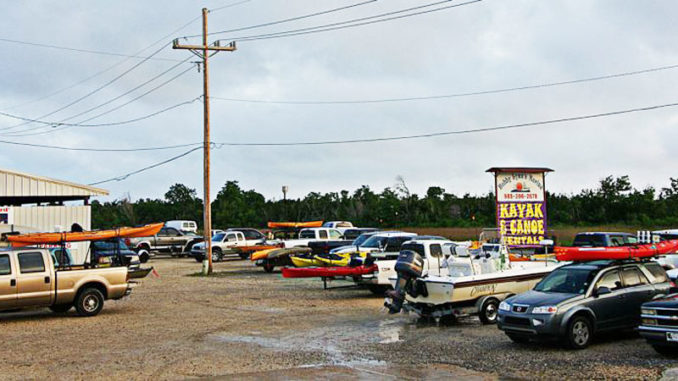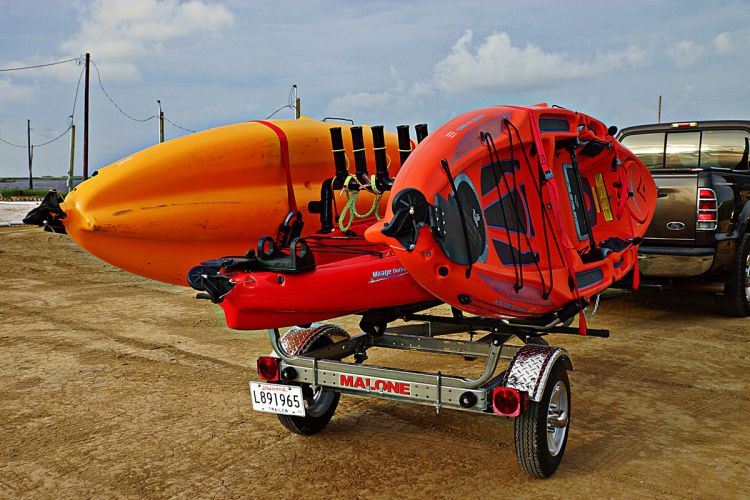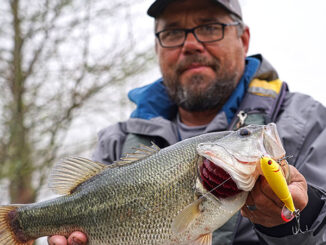
You’ve got to get it to the water
One of the appealing aspects of kayak fishing is a ’yak’s light weight and ease of transport to fishing destinations. However, there is more that goes into getting your kayak from home to the water than meets the eye.
If you have a pickup truck, you have the easiest and most-available options. But, you don’t need to run out and buy a truck if you do not have one. No matter what type of vehicle you have, safe and secure methods of transport are available.
If you have an car or SUV, the only options are to rooftop carry or tow a small trailer.
Rack systems
Most automobiles do not come with factory rack systems so you will either need to permanently install mounting bases or purchases a unit that hooks on above doors.
Four-door vehicles work best, as they spread the mounting surfaces over the roof, providing a more balanced carrying platform. Load bars run the width of the vehicle and can be used to directly carry the kayaks flat on the bars.
The surest way to carry rooftop is by adding a sturdy roof rack specifically designed for kayak carry. A couple of the major brands that make units to fit virtually any vehicle are Malone, Yakima and Thule.
Kayaks are best carried upside down to take advantage of the flat, sturdy gunnels. Other options are J-type racks to carry the kayak on its side or saddles to carry upright. Both attach to the load bars.
Loading kayaks onto a car’s roof-top system can be done by one person, but is more easily accomplished with two.
If you have an SUV, most come with factory-installed roof racks, but usually do not come with load bars sufficient to support the weight of a kayak. Load bars can easily be added in various widths to safely carry one or more kayaks on the roof.
Loading a paddle boat onto a SUV is a bit harder due to their increased height. This can be difficult by a lone angler with all but the lightest of kayaks. It’s best done with a helper.
Trucks for transport
Pickup trucks are, by far, the best vehicle for kayak transport. The simplest and least expensive way to utilize trucks is to simply slide the ’yak into the bed with the tailgate down.
On trucks with longer beds and with kayaks that are not too long, the kayak will be sufficiently supported with just a few feet hanging past the edge of the tailgate.
For safety, hang a brightly colored rag or flag to the tail end of the kayak. Multiple kayaks can be stacked vertically or tilted on their sides to fit in the bed.
For shorter beds and/or compact pickups, you might find that the kayak extends too far past the end of the lowered tailgate to provide adequate support.
This is easily solved with the addition of a bed extender that attaches into the truck’s trailer hitch receiver. Made of steel or aluminum, the extenders adjust to provide a support surface a couple of feet past the edge of and level with the open tailgate. These extenders come in both single and double-wide models.
Gear
While carrying kayaks in the bed of a truck is the easiest option, the kayaks also take up most, if not all, of the available space. Gear and rods have to be strategically placed in and around the kayak to make sure they are not damaged or cannot fall out of the open tailgate.
A solution for rods is adding several rod holders near the front of the bed to hold them vertically out of the way.
Another method to carry is to utilize an overhead rack to carry the kayaks above the roof of the truck, thereby having full use of the bed for gear.
These lumber/work-truck type racks have bars that mount to the front and rear of the bed rails. They are placed just high enough for the kayak to clear the roof by a couple inches. This is a great system for long trips during which you might be carrying extra gear for camping.
Trailers
The use of trailers is also becoming popular for kayak transport. Properly fitted trailers can be used to store the kayak, as well as to get to and from fishing locations.

Specialty kayak trailers from companies such as Malone, Yakima and Trailex are available with a variety of accessories to carry kayaks and gear. Small boat, jet ski and utility trailers also can be adapted for this purpose.
Trailers leave more room in your vehicle, and the boat-style trailers can be used to launch the kayak at a boat ramp.
They also allow you to store a kayak without unloading your gear after each trip. Many lightweight, low-cost trailer options are available, and they can be towed with nearly any vehicle.
Safety first
No matter what method of transport you choose, you need straps to secure the kayak. Rope is not recommended because it can easily slip and stretch.
Most kayak and rack manufacturers recommend using cam straps, which are strong, secure and rarely loosen or slip. The loose end of the strap should always be tied around the tightened strap near the buckle to act as a stop as an extra measure of security.
Ratchet-type straps are not recommended because they can easily be overtightened and damage the kayak.


